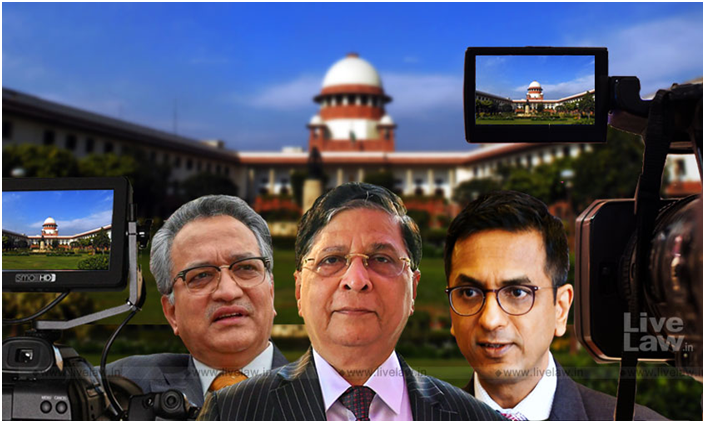Livestreaming Supreme Court proceedings (GS Paper 2, Judiciary)

Context:
- On September 27, the Supreme Court enabled the live streaming of the hearing of cases.
Background:
- The Court’s original decision of September 27, 2018, allowing the live telecast of important proceedings paved the way for this outcome.
- The bench of the then Chief Justice DipakMisra, Justice A M Khanwilkar and Justice D Y Chandrachud had held that the live-streaming of court proceedings is in the public interest.
- The telecast will enliven judicial labour for the public at large to strengthen constitutional values, democracy, and citizenship.
Path-breaking decision:
- Now, a full court of all Supreme Court judges under the leadership of Chief Justice U ULalit took the unanimous decision to live-stream constitutional bench proceedings.
- The Chief Justices (past and present) and the judges of the Supreme Court deserve to be congratulated for enabling a path-breaking and democratic decision that allows the people of India to be able to watch the live proceedings of the Constitutional Bench.
Informed citizenry:
- One, enabling the ordinary people of the country to view, without any barrier, the workings of the highest court of the land will go a long way in instilling faith in the judiciary as well as fostering a critical dialogue with judicial functionaries.
- Transparency and accessibility of the process of justice delivery will strengthen the country’s democracy. Enabling citizens to watch the live proceedings of the Supreme Court is also an important step toward developing an informed citizenry.
Importance of law:
- Two, the decision will enable people to understand the importance of the rule of law. The move will help people appreciate that the judiciary is firm in protecting the rights of the impoverished, historically marginalised and disempowered sections of society.
- There is no better way to “speak truth to power” than in a dignified and self-effacing manner. The direct impact of this decision may not be measured immediately, but it has the potential to build a culture of respect for the rule of law.
Transparency:
- Three, it will promote transparency in judicial decision-making. The decisions taken by the judges are seldom fully understood by common people. Law and justice are too important to be left to lawyers and judges alone.
- Access to live court proceedings will enable millions of ordinary Indians, who may not be trained as lawyers, to not only understand the background and context in which judicial decisions are taken but also appreciate the competing values and conflicting rights at stake.
- By making its proceedings transparent, the SC has shown a deep sense of conviction. It speaks of honesty, integrity, self-reflexivity and rectitude of the institution, characteristics that have been its hallmarks for long.
Boon for legal profession:
- Four, the decision could raise the quality and standards of the legal profession. Lawyers will be better prepared to appear before the court and they will be mindful of not making irresponsible remarks.
- An inclusive approach to public scrutiny could nudge and enable lawyers to take the justice delivery mechanisms far more seriously than they may have in the past.
- It also creates a level playing ground for the younger members of the legal profession as their preparedness and intellectual prowess will be apparent to all.
Legal education:
- The crisis of legal education in India can only be addressed by a significant enhancement in the quality of teaching and research in law schools. The fact that most law graduates are not keen to enter the litigation aspect of the legal profession has been a worrying trend for several years.
- Watching courtroom proceedings, actual arguments by lawyers and searching questions by judges could inspire law students to take up this relatively neglected field. Law faculty members and legal researchers will be motivated to work on new areas of scholarship and research relating to the functioning of the judiciary and legal profession.
Way Forward:
- Technology is a great instrument for forging solidarity and overcoming the obstacles of distance. Live-streaming of the Court’s proceedings will hopefully perform this task and translate the terms of legal justice into public and everyday discourse.
- The distinguished jurist and judge of the US Supreme Court, Justice Oliver Wendell Holmes, famously observed, “The great thing in the world is not so much where we stand, as in what direction we are moving.”
- The judges of the Supreme Court of India have ensured that we are indeed moving in the right direction.


